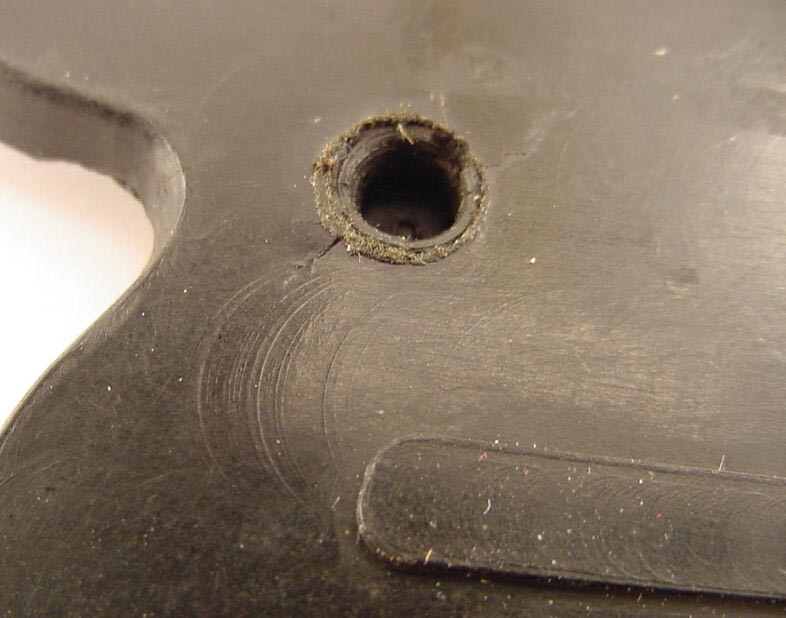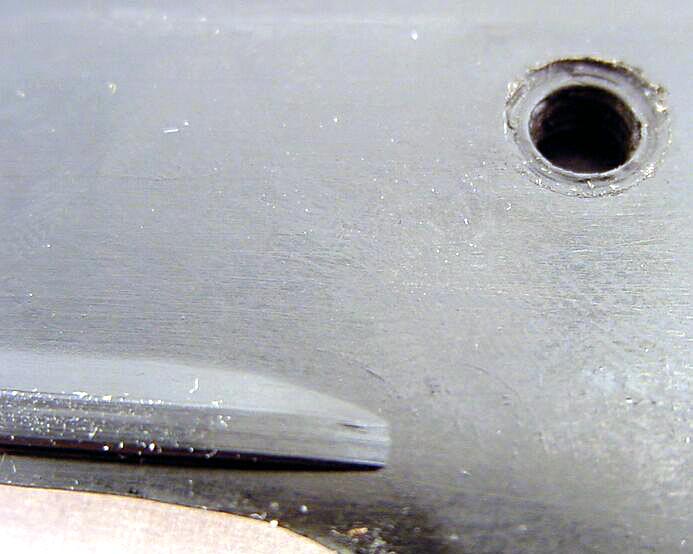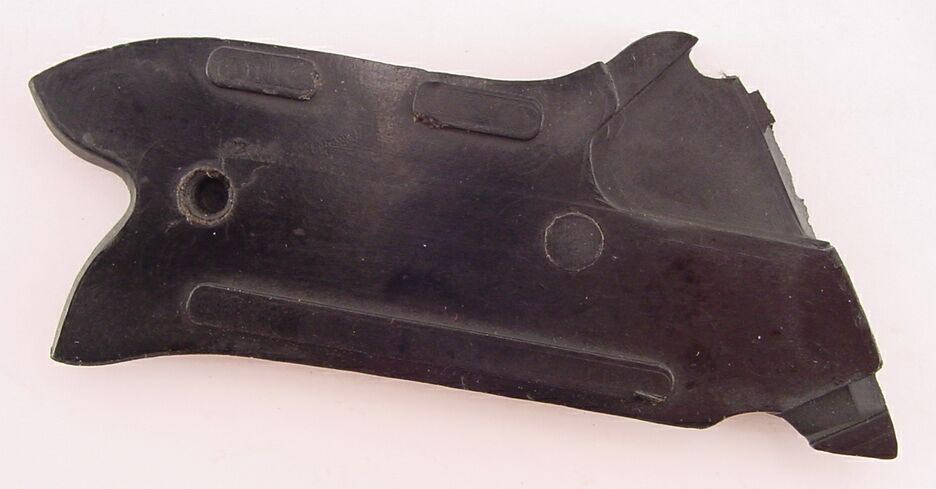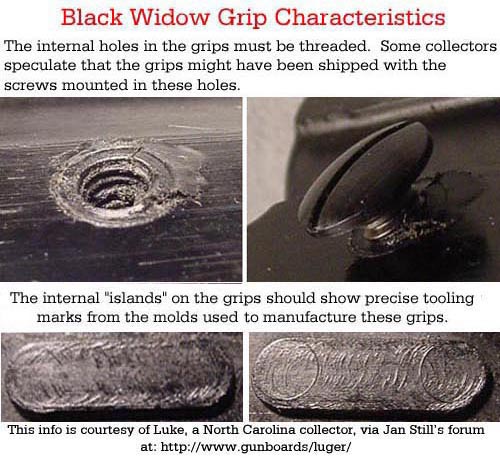
upload photo | donate | calendar
 |
my profile |
register |
faq |
search upload photo | donate | calendar |
|
|
#1 |
|
User
Join Date: May 2004
Location: Milan, IN
Posts: 363
Thanks: 3
Thanked 48 Times in 19 Posts
|
O.K., Iâ??m starting a new thread to try to establish an identifying feature of Black Bakelite type grips. Itâ??s pretty apparent that the market is awash with repro plastic grips.
Gibson in The Krieghoff Parabellum covers both brown and black grips in detail. Gibson states that use of the term Bakelite is technically incorrect as the grips were made of a softer material. Bakelite is a trade name and describes a synthetic made material. One of the properties of Bakelite is it a thermosetting verses a thermoplastic material. Thermosetting material maintains its shape under heat whereas thermoplastic material will alter their shape when subjected to heat. I believe thatâ??s why plastic Repros, thermoplastics, have been reported to bend in hot water and real black grips donâ??t because like Bakelite the real grips are thermosetting. Bakelite is made from Formaldehyde and Carbolic acid which is related to coal. Iâ??m speculating that black Mauser grips being made from a coal derivative were similar enough, at least in looks, and possibly chemical composition to Bakelite, to result in the term Bakelite being used to describe the grips. Gibson states that the brown grips were plastic that appears to most likely be made from a petroleum base. The later black grips were made from a coal derivative that was not as strong as the plastic grip but coal supplies were more available than petroleum. The brown plastic grips were phased out during 1940 and Krieghoff started using the same black bakelite type grips used on Mausers until 1944. The black bakelite material starts to appear in 1939. Gibson doesnâ??t describe any black grips ever being made of petroleum based plastic. The reason to switch from plastic to bakelite type was because petroleum was in short supply. From personal observation of grips at gun shows and photos posted on the two Luger forums, I have noticed that one type of grip that has been reported to be an original Mauser black grip possesses a differentiating characteristic that if present in all original black grips would be a basis for identifying real black grips from plastic repros. The characteristic is shown in photos from forum members and is the fibrous material that shows up in the screw holes and other locations that appear as a straw like substance imbedded in the material. Following photos were taken from luger forums and unfortunately I haven't the names to give credit.      (photo syntax edited by admin-JS to display rather than link) My conjecture is that since the grips were not as strong as the plastic type, a binder or filler was utilized to provide some attribute that was considered desirable. Possibly to add strength or keep the grip together if damaged. The grip would be less likely to shatter and break in small pieces since the material was not a strong material and may break apart if subjected to a hard blow. Of course, this doesnâ??t preclude Bakelite type grips being made without the binder material. In this case it appears that the only true identifier would be the heat test, (hot water?) to determine if the material was thermosetting, i.e. didnâ??t bend under heat since thermoplastic, (bends under heat) has not been reported being used to make grips. As an aside, the photos Gibson use in his book for the Mauser grips donâ??t exhibit the qualities that many folks attribute to real grips e.g. the back of the grips are not machined or exhibit machine marks from the dies. The second addition was published in 1988 and I donâ??t know when the photos were taken. For the Mauser grips, the photos and text describe/show one screw hole in each grip located at the inside top of right grip and inside bottom of left grip. All brown plastic Krieghoffs have two holes in back of each grip; one on top and one on the bottom. Iâ??m asking all the folks that would be kind enough to participate in trying to establish if original black Bakelite type grips exhibit the fibrous material as shown in the accompanying photos. In many cases you must look with a magnifier/loupe to see the straw like material. It would be nice if folks that could trace the grips and Luger such that there was no question that the grips are real would participate. Many folks have already used the hot water test and it would be nice to know if the grips that passed the hot water test, i.e. didnâ??t bend, exhibit the fibrous filler material. Iâ??d also like to know how the folks that had grips that bent under hot water performed the test. How hot was the water, how long was the grip subjected to the heat? Iâ??m trying to establish if any bakelite type grips were made without the fibrous material. If someone applied heat and the grip didnâ??t bend and the grip didnâ??t exhibit fibrous material it could mean that bakelite grips were made without the fibrous additive. Iâ??m searching for anything that may zero in on factors that could be utilized to ID real grips. There are a lot of smart folks out there and Iâ??d appreciate any input that may help in performing this survey. One last item, Jan Still stated that there was a posting that listed the material that the grips were made of; if anyone knows where this info resides, please let us know. Thanks in advance. Tom |
|
|

|
|
|
#2 |
|
User
Join Date: May 2004
Location: Milan, IN
Posts: 363
Thanks: 3
Thanked 48 Times in 19 Posts
|
Fixed
|
|
|

|
|
|
#3 |
|
Lifer
Lifetime Forum Patron Join Date: Jun 2002
Location: The Capital of the Free World
Posts: 10,154
Thanks: 3,003
Thanked 2,306 Times in 1,097 Posts
|
I have never seen true orginal "black widow" bakelite grips that didn't have the fiberous material as part of their construction, and one threaded hole on each grip.
The grips you show in photos 1-4 appear genuine to me. Luke and I collaborated on a study some many months ago about these grips... The circular tooling marks on genuine grips are so precise, that we speculated that perhaps ALL of these grips came out of the exact same mold, or that the production molds may have all been made from the EXACT same engineering sample grip... If you photo-overlay the circular marks on the interior islands, you can see that these marks like up EXACTLY... If repro-technology has reached the point where they can reproduce these marks exactly (I don't think that they have)... then we might have something to worry about. What they haven't reproduced is the "look" and 'shine' and fit of the original grips... at least not yet. Those original grips were as pefectly engineered as the Luger itself! ...at least that is my 
__________________
regards, -John S "...We hold these truths to be self-evident that ALL men are created EQUAL and are endowed by their Creator with certain UNALIENABLE rights, and among these are life, LIBERTY, and the pursuit of happiness..." |
|
|

|
|
|
#4 |
|
User
Join Date: May 2004
Location: Milan, IN
Posts: 363
Thanks: 3
Thanked 48 Times in 19 Posts
|
John,
I appreciate your observations. I'll have to admit that in all the postings I've read, and there have been many, nobody has ever identified the fibrous material as being a salient feature of original black grips. I believe, if in fact proven reliable, this could be one of the most obvious traits to look for in ascertaining the authenticity of black grips. I know it's what I look for. Thanks, Tom |
|
|

|
|
|
#5 |
|
Lifer
Lifetime Forum Patron Join Date: Jun 2002
Location: The Capital of the Free World
Posts: 10,154
Thanks: 3,003
Thanked 2,306 Times in 1,097 Posts
|
The fibrous material is one of the reasons that if the finish gets scratched, there is simply no way to restore the smooth shiny appearance of a genuine grip... anyplace that gets scratched or sanded will be eternally gray and 'fuzzy'... The original smooth finish is a product of the actual hot mold process, and can't be 'cold' duplicated.
__________________
regards, -John S "...We hold these truths to be self-evident that ALL men are created EQUAL and are endowed by their Creator with certain UNALIENABLE rights, and among these are life, LIBERTY, and the pursuit of happiness..." |
|
|

|
|
|
#6 |
|
User
Join Date: May 2004
Posts: 1,538
Thanks: 18
Thanked 36 Times in 21 Posts
|
Just curious.. how much are those black grips worth? I have bought two Lugers with black grips that appears to be genuine, without any extra price due to the grips.
__________________
Previously known as Morgan Kane |
|
|

|
|
|
#7 |
|
User
Join Date: May 2004
Location: Milan, IN
Posts: 363
Thanks: 3
Thanked 48 Times in 19 Posts
|
Morgan,
From my experience, $150 to $200 at gun shows in eastern USA. Tom |
|
|

|
|
|
#8 |
|
Lifer
Lifetime Forum Patron Join Date: Jun 2002
Location: The Capital of the Free World
Posts: 10,154
Thanks: 3,003
Thanked 2,306 Times in 1,097 Posts
|
I have seen them go for as little as $85 to the high end that Tom mentioned all depending on who was selling and who was buying and of course "condition, condition, condition" is everything...
__________________
regards, -John S "...We hold these truths to be self-evident that ALL men are created EQUAL and are endowed by their Creator with certain UNALIENABLE rights, and among these are life, LIBERTY, and the pursuit of happiness..." |
|
|

|
|
|
#9 |
|
User
Join Date: May 2004
Location: Milan, IN
Posts: 363
Thanks: 3
Thanked 48 Times in 19 Posts
|
Rick W,
You didn't misunderstand. Morgan asked a question and I tried to answer the question. I'd like any information that will shed light on how the original grips were made. Thanks, Tom |
|
|

|
|
|
#10 |
|
New User
Join Date: Mar 2005
Location: Fullerton,CA
Posts: 4
Thanks: 0
Thanked 0 Times in 0 Posts
|
I'm a new member and coincidentally recently purchased my first Luger. This thread has interest to me as my pistol is a byf 42 with black grips. There was no mention about numbering to be found inside the grips so I removed the left grip and found that it bears a little number 38 as is found on all of the numbered parts on my pistol. The other items covered in this post such as mold marks, hole threads, etc. is correct on my Luger so I feel safe in assuming that it's all original.
I would like to add also that this forum for the Luger and its variations has to be the best that I've ever encountered on the internet. |
|
|

|
|
|
#11 |
|
New User
Join Date: Mar 2005
Location: Fullerton,CA
Posts: 4
Thanks: 0
Thanked 0 Times in 0 Posts
|
I may have neglected to sign on my last post. My name is Larry Stauch.
Thanks. |
|
|

|
|
|
#12 |
|
User
Join Date: May 2004
Location: Milan, IN
Posts: 363
Thanks: 3
Thanked 48 Times in 19 Posts
|
Larry,
Welcome to the forum. I agree, this forum has the nicest, knowledgable, most helpful folks you'll ever run across. Jan Still has a luger forum at the link shown below. Many of the same folks participate there as well. Once again, Welcome! http://www.gunboards.com/luger/ |
|
|

|
|
|
#13 |
|
New User
Join Date: Mar 2005
Location: Fullerton,CA
Posts: 4
Thanks: 0
Thanked 0 Times in 0 Posts
|
Thanks for the heads up.
I'll head over to the other forum too. Larry |
|
|

|
|
|
#14 |
|
User
Join Date: Jun 2002
Location: The USA
Posts: 5,919
Thanks: 0
Thanked 6 Times in 4 Posts
|
Hi Larry,
Do the little numbers on the inside surfaces of your BW grips look like they were moulded-in, stamped, or scribed/engraved...? I am curious as I do not recall anyone mentioning numbers being present on the BW grips.. There have been a few members that have reported numbers on the bottom of black plastic magainzes...that are, too, usually not numbered. Belated welcome to the Luger Forum...! Regards, Pete... 
|
|
|

|
|
|
#15 |
|
New User
Join Date: Mar 2005
Location: Fullerton,CA
Posts: 4
Thanks: 0
Thanked 0 Times in 0 Posts
|
Pete,
Yes the numbers are stamped in very small script on each inside panel. The style of script appears identical to the serial number script as appears on the outside of the pistol. I am pretty sure that they are correct. The presence of the numbers is what I missed when I first inspected the grips. The numbers are very small at exactly 2 mm in height. I verified this with a digital caliper. They are located in the middle on the inside of each grip. Perhaps I have uncovered something new in the manufacture of war era Lugers. Who knows? The grip material is a fiber reinforced plastic it seems. If you or anyone can throw light on this little mystery please let me know! Larry S. |
|
|

|
 |
|
|